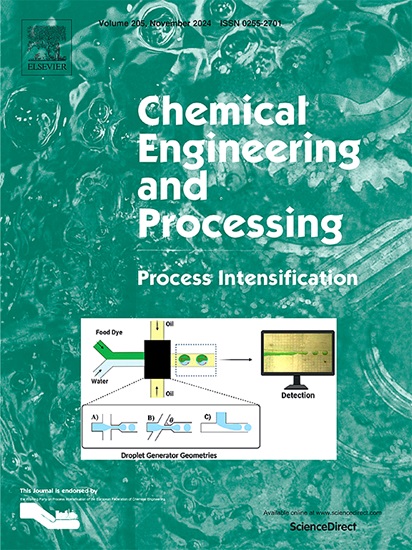Enhanced dye wastewater treatment via PVDF membrane distillation: Influence of dye classes on performance and fouling
IF 3.8
3区 工程技术
Q3 ENERGY & FUELS
Chemical Engineering and Processing - Process Intensification
Pub Date : 2025-02-01
DOI:10.1016/j.cep.2024.110129
引用次数: 0
Abstract
This study examines the application of polyvinylidene fluoride (PVDF) membrane distillation for the 12-hour treatment of dye wastewater, investigating the impact of various dye classes on membrane performance and fouling behaviour. Focusing on anionic dyes (Acid Red 27, Congo Red, Direct Red 80, Reactive Red 120), cationic dye (Basic Red 5), and non-ionic dye (Disperse Red 13), exceptional color rejection rates of over 99.5% were achieved. Acid Red and Direct Red displayed the highest permeate fluxes, achieving 20 liters per square meter per hour (LMH), while Disperse Red, due to its non-ionic properties, yielded a lower flux of 12 LMH. Field emission scanning electron microscopy (FESEM), energy-dispersive X-ray spectroscopy (EDX), and Fourier-transform infrared spectroscopy (FTIR) analyses revealed key dye-membrane interactions, indicating that Congo Red showed the least fouling (13% flux decline). In comparison, Basic Red and Disperse Red produced the highest fouling index at 33.3%. Hermia's modelling confirmed compatibility with cake filtration and intermediate pore-blocking models, achieving an R² of 0.97. The PVDF membrane's durability across various dye classes emphasizes its potential for temperature-driven, sustainable wastewater treatment. These results highlight the significance of dye chemistry in optimizing membrane distillation processes for industrial wastewater management.

求助全文
约1分钟内获得全文
求助全文
来源期刊
CiteScore
7.80
自引率
9.30%
发文量
408
审稿时长
49 days
期刊介绍:
Chemical Engineering and Processing: Process Intensification is intended for practicing researchers in industry and academia, working in the field of Process Engineering and related to the subject of Process Intensification.Articles published in the Journal demonstrate how novel discoveries, developments and theories in the field of Process Engineering and in particular Process Intensification may be used for analysis and design of innovative equipment and processing methods with substantially improved sustainability, efficiency and environmental performance.

 求助内容:
求助内容: 应助结果提醒方式:
应助结果提醒方式:


